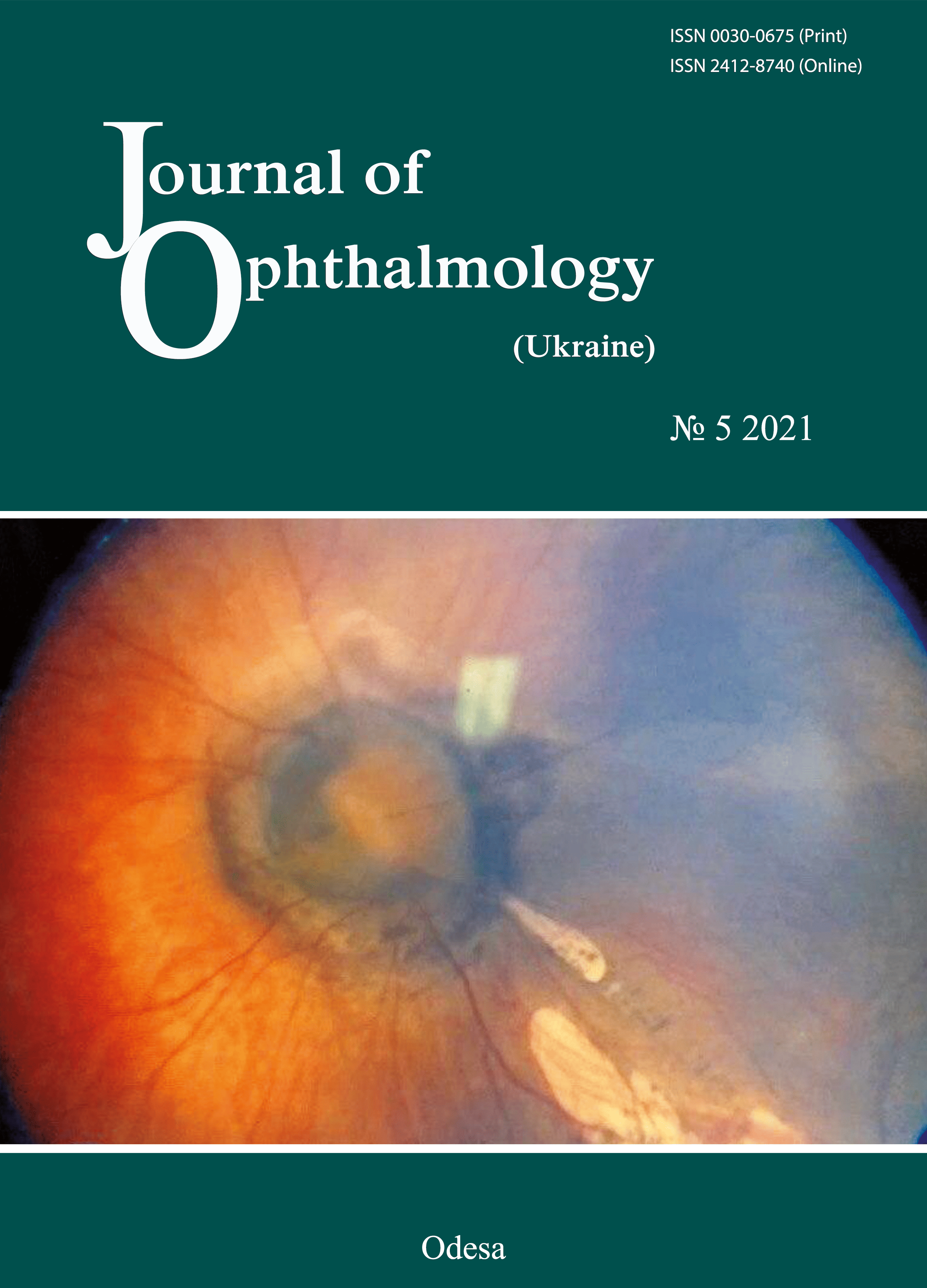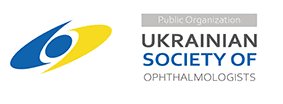Bilateral morning glory syndrome associated with persistent fetal vasculature syndrome and corpus callosum agenesis: a case report
DOI:
https://doi.org/10.31288/oftalmolzh202157176Keywords:
morning glory syndrome, persistent fetal vasculature syndrome, congenital CNS and bone anomaliesAbstract
Background: The morning glory (MG) syndrome is a rare, sporadic and commonly unilateral anomaly. The MG and persistent fetal vasculature (PVF) syndromes are generally considered as isolated ocular manifestations of failures in various stages of embryogenesis of the eye.
Purpose: To describe the clinical manifestations of a bilateral combined ocular pathology, the MG syndrome and PVF syndrome, associated with congenital central nervous system (CNS) and bone anomalies.
Material and Methods: We described a rare variant of binocular manifestation of the MG syndrome associated both with the PVF syndrome and CNS involvement in a 7-month infant.
Results: In the pediatric case reported here, the bilateral combination of MG syndrome and PVF syndrome is accompanied by congenital CNS anomalies, corpus callosum agenesis and vicarious ventriculomegaly. To the best of our knowledge, this congenital association has been not reported previously, which made us to report this case.
Conclusion: Morning glory syndrome is a rare congenital disorder whose pathogenesis is still not fully understood. The rare infant case reported here demonstrates an association of the MG syndrome with another congenital anomaly of the eye (the persistent fetal vasculature syndrome) and a major congenital anomaly of the CNS, corpus callosum agenesis, which requires not only detailed and comprehensive medical evaluation, but also longitudinal patient surveillance in cooperation with allied specialties like neuropathology, pediatrics, etc.
References
1. Bobrova NF, Vit VV. [Atlas of congenital and hereditary disease of the eye]. Odessa: Palmira; 2006. p.68-9. Russian.
2. Tyszka JM, Kennedy DP, Adolphs E, Paul LK. Intact Bilateral Resting-State Networks in the Absence of the Corpus Callosum. J Neurosci. 2011 Oct 19; 31(42): 15154-162. https://doi.org/10.1523/JNEUROSCI.1453-11.2011
3. Brown GC, Tasmand WS. Congenital Anomalies of the Optic Disc. New York, NY: Grune & Stratton;1983. p. 123-70.
4. Ellika S, Robson CD, Heidary G, Paldino MG. Morning glory disc anomaly: characteristic MR imaging findings. Am J Neuroradiol. 2013 Oct;34(10):2010-4.https://doi.org/10.3174/ajnr.A3542
5. Strominger MB. Morning Glory Syndrome. Neuro-Ophthalmology. 2015 Oct 14.
6. Bobrova NF, Skripnichenko ZM. [Toxic, congenital, and secondary cataracts]. Odessa: Feniks; 2017. Russian.
7. Birnholz JC, Farrell EE. Fetal hyaloid artery: timing of regression with US. Radiology. 1988 Mar;166(3):781-3.https://doi.org/10.1148/radiology.166.3.3277246
8. Goldberg MF. Persistent fetal vasculature (PFV): an integrated interpretation of signs and symptoms associated with persistent hyperplastic primary vitreous (PHPV). Am J Ophthalmol. 1997 Nov;124(5):587-626.https://doi.org/10.1016/S0002-9394(14)70899-2
9. Reis W. Eine wenig bekannte typische Missbildung am Sehenrveheintritt: Unschriebene Grubenbildung auf der Papilla n. optici. Z Augenheilkd. 1908;19:505-28.https://doi.org/10.1159/000291456
10. Handmann M. Erbliche vermutlich angeborene zentrale gliose Entartung des Sehnerven mit besonderer Beteilingung der Zentralgefaesse. Klin Monatsbl Augenheilkd. 1929;83:145-52.
11. Kindler P. Morning glory syndrome: unusual congenital optic disk anomaly. Am J Ophthalmol. 1970 Mar;69(3):376-84.https://doi.org/10.1016/0002-9394(70)92269-5
12. Miller NR, Newman NJ, eds. Anomalies of the optic disc. In: The essentials: Walsh & Hoyt's Clinical Neuroophthalmology. 5th ed. Baltimore: Williams & Wilkins. p.117-23.
13. Safari A, Jafari E, Borhani-Haghighi A. Morning glory syndrome associated with multiple sclerosis. Iran J Neurol. 2014 Jul 4;13(3):177-80.
14. Steinkuller PG. The morning glory disk anomaly: Case report and literature review. J Pediatr Ophthalmol Strabismus. Mar-Apr 1980;17(2):81-7.https://doi.org/10.3928/0191-3913-19800301-06
15. Traboulsi EL, Jurdi-Nuwayhid F, Torbey NS, et al. Aniridia, atypical iris defects, optic pit and the morning glory disc anomaly in a family. Ophthalmic Paediatr Genet. 1986 Aug;7(2):131-5.https://doi.org/10.3109/13816818609076122
16. Dempster AG, Lee WR, Forrester JV, McCreath GT. The 'morning glory syndrome' - a mesodermal defect? Ophthalmologica. 1983;187:222-30.https://doi.org/10.1159/000309330
17. Pollock S. The morning glory disc anomaly: contractile movement, classification, and embryogenesis. Doc Ophthalmol. 1987 Apr;65(4):439-60.https://doi.org/10.1007/BF00143047
18. Collins ET. Developmental deformities of the crystalline lens. Ophthalmoscope. 1908; 6:577-83, 663.
19. Khvatova AV, Sudovskaia TV. [Clinical features, diagnostic and treatment options for unilateral congenital cataracts associated with persistent primary vitreous syndrome: a textbook for physicians]. Moscow; 2002. Russian.
20. Antely I, Cohen E, Karshai E, BenEzra D. Unilateral persistent hyperplastic primary vitreous: course and outcome. J AAPOS. 2002 Apr;6(2):92-9. https://doi.org/10.1067/mpa.2002.121324
21. Kanigowska K, Grałek M, Chipczyńiska B, Hautz W. [Problems in surgical management of persistent hyperplastic primary vitreous in children]. Klin Oczna. 2006;108(1-3):51-4. Polish.
22. Roche O, Sylla FK, Beby F, et al. [Persistence and hyperplasia of primary vitreous]. J Fr Ophtalmol. 2007 Jun;30(6):647-57.https://doi.org/10.1016/S0181-5512(07)89674-4
23. Azuma N, Yamaguchi Y et.al. Mutations of the PAX6 gene detected in patients with a variety of optic-nerve malformations. Am J Hum Genet. 2003 Jun;72(6):1565-70.https://doi.org/10.1086/375555
24. Krasnovid TA, Grubnik NP. [Morning glory syndrome associated with persistent hyaloid artery]. Oftalmol Zh. 2011;6:53-5. Russian.
25. Matsubara A, Ozeki H, Matsunaga N, et al. Histopathological examination of two cases of anterior staphyloma associated with Peters' anomaly and persistent hyperplastic primary vitreous. Br J Ophthalmol. 2001 Dec;85(12):1421-5.https://doi.org/10.1136/bjo.85.12.1421
26. Cenamo G, Liguori G, Pezone A, Laccarino G. Morning glory syndrome associated with marked persistent hyperplastic primary vitreous and lens colobomas. Br J Ophthalmol. 1989 Aug;73(8):684-6.https://doi.org/10.1136/bjo.73.8.684
27. Fei P, Zhang Q, Li J, Zhao P. Clinical characteristics and treatment of 22 eyes of morning glory syndrome associated with persistent hyperplastic primary vitreous. Br J Ophthalmol. 2013 Oct;97(10):1262-7.https://doi.org/10.1136/bjophthalmol-2013-303565
28. Xu LT, Grigorian AP. Morning Glory anomaly. Neuro-Ophthalmology. 2020;5.
29. Loddenkemper T, Friedman NR, Ruggieri PM, et al. Pituitary stalk duplication in association with moya moya disease and bilateral morning glory disc anomaly. J Neurol. 2008 Jun;255(6):885-90.https://doi.org/10.1007/s00415-008-0799-5
30. Quah BL, Hamilton J, Blaser S, et al. Morning glory disc anomaly, midline cranial defects and abnormal carotid circulation: an association worth looking for. Pediatr Radiol. 2005 May; 35(5):525-8.https://doi.org/10.1007/s00247-004-1345-y
31. Ponnatapura J. Morning glory syndrome with Moyamoya disease: A rare association with role of imaging. Indian J Radiol Imaging. Apr-Jun 2018;28(2):165-8.https://doi.org/10.4103/ijri.IJRI_219_17
32. Komiyama M, Yasui T, Sakamoto H, et al. Basal meningoencephalocele, anomaly of optic disc and panhypopituitarism in association with moyamoya disease. Pediatr Neurosurg. 2000 Aug;33(2):100-4.https://doi.org/10.1159/000028984
33. Lee BJ, Traboulsi EI. Update on the morning glory disc anomaly. Ophthalmic Genet. 2008 Jun;29(2):47-52.https://doi.org/10.1080/13816810801901876
34. Brodsky MC. Pediatric Neuro-Ophthalmology. 2nd ed. New York: Springer; 2010.https://doi.org/10.1007/978-0-387-69069-8
Downloads
Published
How to Cite
Issue
Section
License
Copyright (c) 2025 Н. Ф. Боброва, Т. В. Романова, А. В. Шилик

This work is licensed under a Creative Commons Attribution 4.0 International License.
This work is licensed under a Creative Commons Attribution 4.0 International (CC BY 4.0) that allows users to read, download, copy, distribute, print, search, or link to the full texts of the articles, or use them for any other lawful purpose, without asking prior permission from the publisher or the author as long as they cite the source.
COPYRIGHT NOTICE
Authors who publish in this journal agree to the following terms:
- Authors hold copyright immediately after publication of their works and retain publishing rights without any restrictions.
- The copyright commencement date complies the publication date of the issue, where the article is included in.
DEPOSIT POLICY
- Authors are permitted and encouraged to post their work online (e.g., in institutional repositories or on their website) during the editorial process, as it can lead to productive exchanges, as well as earlier and greater citation of published work.
- Authors are able to enter into separate, additional contractual arrangements for the non-exclusive distribution of the journal's published version of the work with an acknowledgement of its initial publication in this journal.
- Post-print (post-refereeing manuscript version) and publisher's PDF-version self-archiving is allowed.
- Archiving the pre-print (pre-refereeing manuscript version) not allowed.












